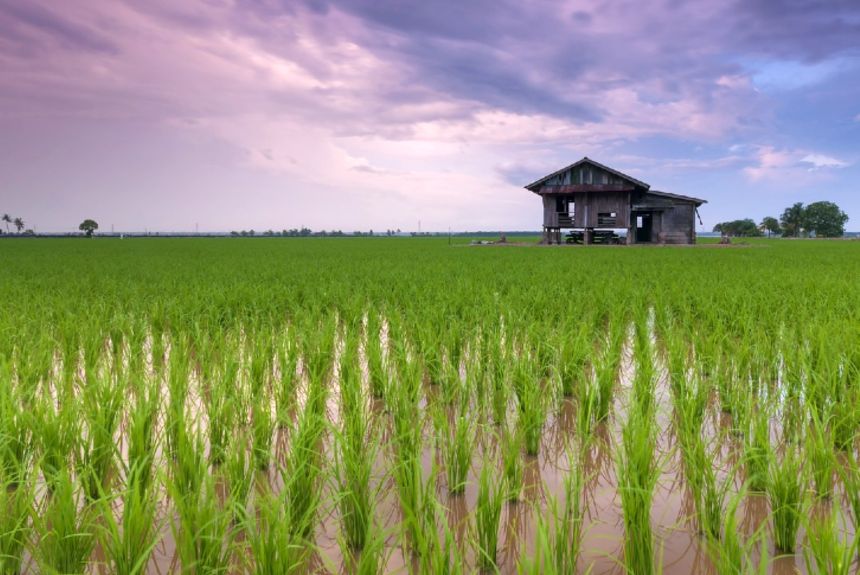Salinity intrusion has been a problem in the Mekong River Delta (MRD), affecting rice production and potentially impacting food security and people’s livelihoods.
Climate change is raising sea levels and increasing saline intrusion. The Vietnamese government says that 40 per cent of the delta region could be underwater if the sea level rises by 1 meter in decades to come. Sea levels are rising at 3mm per year (Aljazeera News, 2017).
The Mekong Common article “As salinity intrudes into the Mekong Delta, farmers lose yields and income” mentions that “seawater intrusion has been expanding in the 13 provinces of the delta region due to climate change, exposing its rice fields, fruits, and vegetable gardens” (Mekong Commons, 2017).
Another news report reported that saltwater had entered canals in rice fields in Ben Tre up to 50 km deep inland. In the Ba Tri District, saltwater content in rice fields had reached 0.1 – 0.15 per cent. According to the district’s Agriculture and Rural Development Division, the salt content rate could affect the district’s 11,000 hectares of winter-spring rice fields (Viet Nam News, 2019, 9 March).
The report “The drought and salinity intrusion in the Mekong River Delta of Vietnam” (April 2016) presents a comprehensive look at the impacts of sea-level rise, drought, the El Niño phenomenon, and altered precipitation events on the Mekong River Delta and its rice paddies.
Background of the Mekong River Delta and its significance to Food Production
The Mekong River Delta covers an area of about 39,000 square kilometres and consists of 13 provinces in the south of Vietnam. According to a report, it has flat terrain with an average elevation of less than 1 meter above sea level.
Agricultural land accounts for 2.6 million hectares and produces 50% of the total food in Vietnam, providing food security and livelihoods for 70% of the region’s population. The report says that the development of the country’s agriculture sector directly impacts poverty reduction.
One of its main products is rice, which contributes 50% of the country’s total rice yield. Other products include fruits, fish, vegetables, sugar cane, maize, mango, and coconut.
What is the government doing about it?
The Mekong Commons reports that the government has built dykes and sluice gates to control seawater intrusion into the coastal provinces. Given the delta’s contribution to the country’s economy, damages from saltwater intrusion can be significant. In 2015, the estimated loss was US$445 million or 1.5 per cent of the annual rice production (Mekong Commons, 2017).
Because of the increasing threats of sea-level rise and saltwater intrusion, the government and its people have devised the following solutions (Viet Nam News, 2019, 27 April).
- The people dredged canals and ponds, dug wells, and built temporary dams and pumping stations to supply fresh water for drought and saltwater-affected areas.
- Authorities have encouraged farmers to strictly follow the rice-growing sowing schedules between April and June and at different periods.
- The government recommends that farmers use high-quality, drought and saltwater-resistant rice varieties.
- Vietnam’s Department of Agriculture has ordered plans to develop a water supply for the autumn-summer cropping period.
- Maximizing the use of rainwater and those without irrigation should sow the autumn-summer rice crop only when there is rain.
The report, “The drought and salinity intrusion in the Mekong River Delta of Vietnam“, also presents a comprehensive recommendation regarding the problem.
Sources:
Duyen, C.M. (2017, June 22). As salinity intrudes into the Mekong Delta, farmers lose yields and income. Mekong Commons [news]. Retrieved from http://www.mekongcommons.org/salinity-intrudes-mekong-delta-farmers-lose-yields-income/
Rising sea level a threat to Vietnamese farmers. (2017, May 5). Al Jazeera News. Retrieved from https://www.aljazeera.com/news/2017/05/rising-sea-level-threat-vietnamese-farmers-170505071648649.html
Tre, B., Vinh T., & Giang K. (2016, April 25-28). The drought and salinity intrusion in the Mekong River Delta of Vietnam. CGIAR Research Centers in Southeast Asia. Retrieved from https://www.researchgate.net/publication/309481170_The_drought_and_salinity_intrusion_in_the_Mekong_River_Delta_of_Vietnam_-_Assessment_report
Delta takes steps against saltwater intrusion (2019, April 27). Viet Nam News. Retrieved from https://vietnamnews.vn/society/519238/delta-takes-steps-against-saltwater-intrusion.html#I0QpQAOaL7eDHxt2.97
Saltwater intrusion hits Mekong Delta (2019, March 9). Viet Nam News. Retrieved from https://vietnamnews.vn/society/519238/delta-takes-steps-against-saltwater-intrusion.html#I0QpQAOaL7eDHxt2.97



Leave a Reply